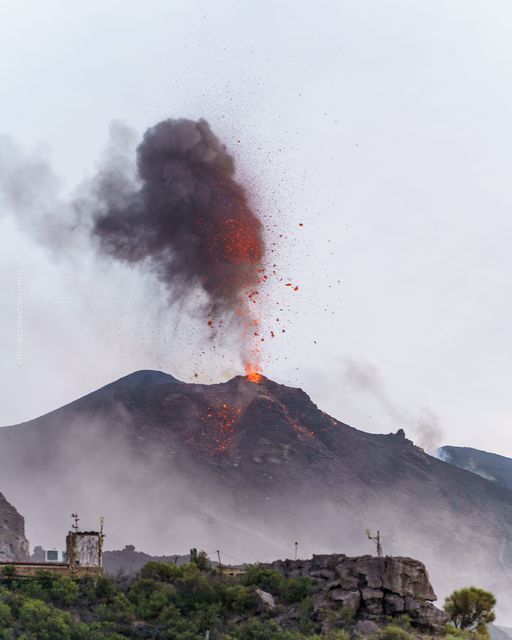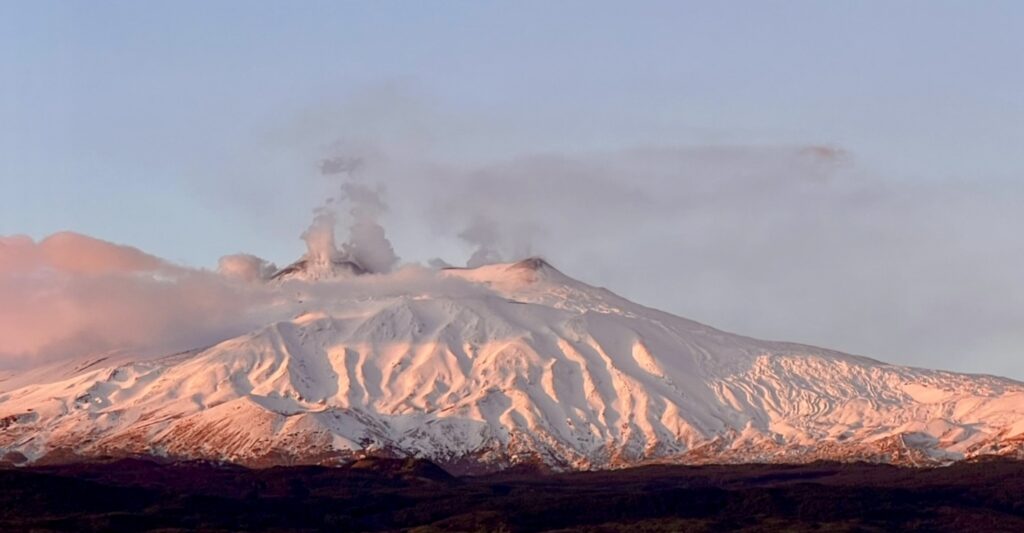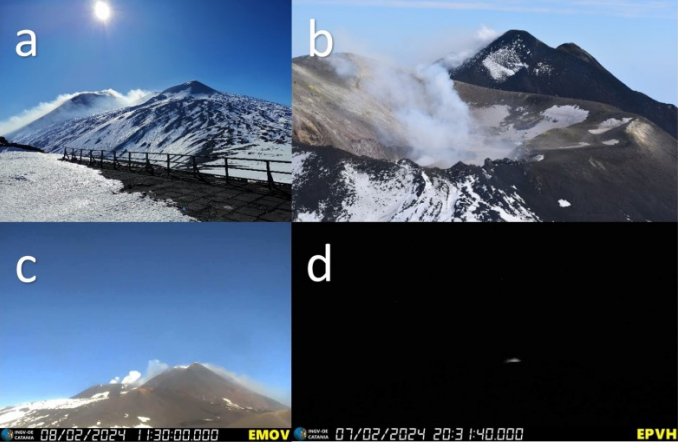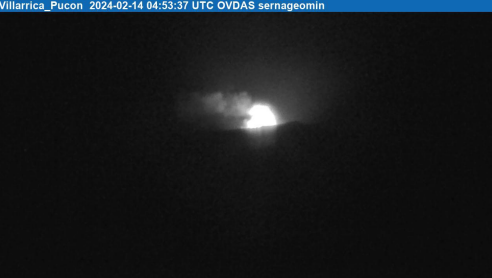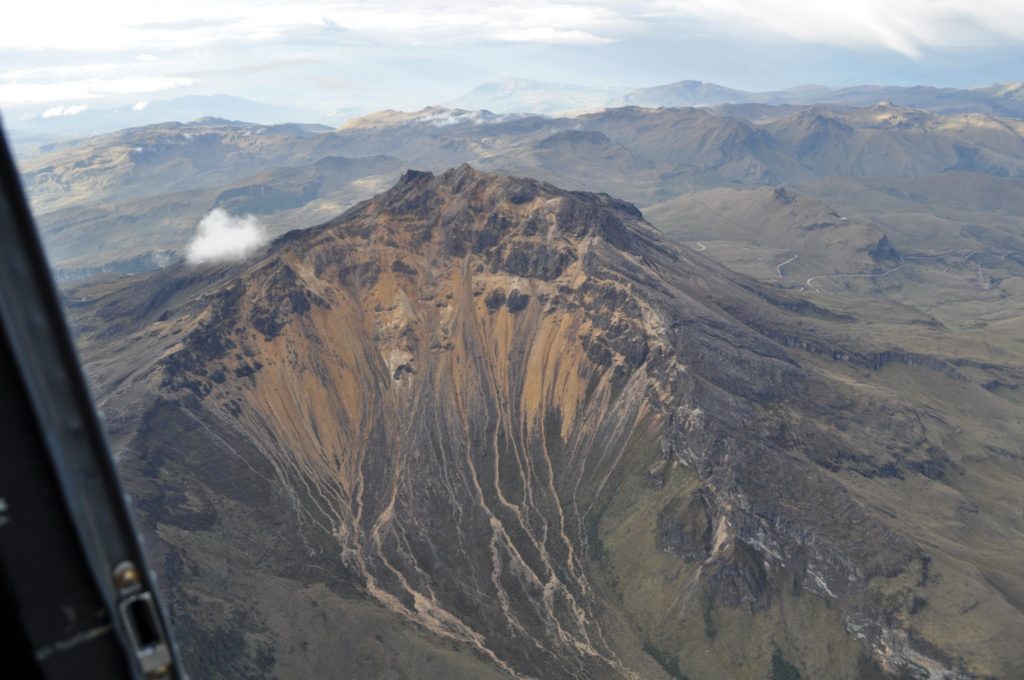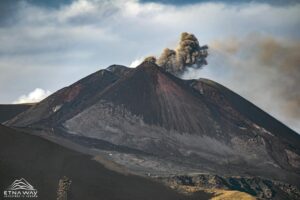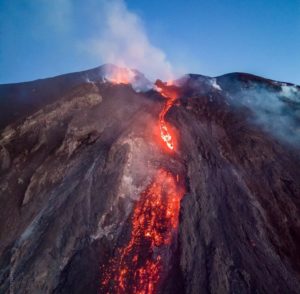February 14 , 2024.
Italy , Stromboli :
WEEKLY BULLETIN, from February 5, 2024 to February 11, 2024. (issue date February 13, 2024)
SUMMARY STATEMENT OF ACTIVITY
In light of the monitoring data, it appears:
1) VOLCANOLOGICAL OBSERVATIONS: During this period, normal Strombolian activity was observed, interrupted by a high energy explosive sequence coming from the South Central zone. The total hourly frequency fluctuated between average values (9-14 events/h). The intensity of the explosions was low in the North Crater area and variable from low to high in the South Central area.
2) SISMOLOGY: The monitored seismological parameters do not show significant variations.
3) GROUND DEFORMATIONS: The inclinometer and GNSS networks measured the variations at the Timpone del Fuoco station on February 7 and 8 respectively.
4) GEOCHEMISTRY: SO2 flux at medium level
CO2 flux in the summit area shows high values
C/S ratio in the plume: there are no updates.
Helium Isotope Ratio in Thermal Aquifer: There are no updates.
CO2 flow in Scari: values on average levels.
5) SATELLITE OBSERVATIONS: Thermal activity observed by satellite was generally weak.
VOLCANOLOGICAL OBSERVATIONS
In the observed period, the eruptive activity of Stromboli was characterized through the analysis of images recorded by the INGV-OE surveillance cameras located at Pizzo (SPT), at altitude 190 m (SCT-SCV) and at Point dei Corvi (SPCT). . The explosive activity was mainly produced by 3 (three) eruptive vents located in the North zone of the crater and by 2 (two) vents located in the South Central zone.
It should be noted that the Pizzo camera was without power on February 10 and 11, probably due to cloud cover. On February 9, an explosive sequence of high energy affected the South Central zone.
Observations of explosive activity captured by surveillance cameras
In the area of the North crater (N), with two vents, one located in sector N1 and one located in sector N2, explosive activity was observed, mainly of low intensity (less than 80 m in height). The products emitted in the eruption were mainly coarse materials (bombs and lapilli). The average frequency of explosions oscillated between 3 and 4 events/h.
In the South-Central (CS) zone, sectors S1 and C did not show significant activity, while sector S2 showed explosions of intensity varying from low (less than 80 m in height) to high ( greater than 150 m in height) emitting coarse materials mixed with fine materials. The average frequency of explosions varied between 5 and 10 events/h.
Significant images of the explosive sequence of February 9 taken by the infrared camera at altitude 190 m (TCS).
Explosive sequence on February 9.
On February 9, an explosive sequence was produced from the South-Central zone of the crater (CS). Below is a brief description where times are UTC.
At 7:55:44 p.m., the initial explosion of the sequence began from sector S2 of the South-Central area of the crater; it was the most energetic: the coarse products (shreds of lava, bombs and lapilli) had a radial distribution, falling in abundance on the slopes of the crater terrace and, with the ash cover produced, exceeded 350 m in height. The latter dispersed towards the eastern quadrants of the island. The duration was approximately 40 s.
At 7:58:04 p.m. a second explosion of lesser intensity (around 150 m high) also hit sector S2, lasting around 12 seconds.
At 19:58:20, a third explosion occurred, similar to the previous one, but followed by a strong emission of ash with dispersion towards the East. The duration was approximately 50 s.
These three events were followed by a few low-intensity ash explosions (less than 80 m in height).
The total duration of the sequence was almost 4 minutes.
Source : INGV
Photos : Stromboli stati d’animo / Sebastiano Cannavo , INGV.
Italy / Sicily , Etna :
WEEKLY BULLETIN, from February 5, 2024 to February 11, 2024. (issue date February 13, 2024)
SUMMARY STATEMENT OF ACTIVITY
In light of the monitoring data, it appears:
1) VOLCANOLOGICAL OBSERVATIONS: Degassing activity from the Bocca Nuova crater and the South-East crater.
2) SEISMOLOGY: Low seismic activity due to fracturing. Average amplitude of the volcanic tremor at mid-level.
3) INFRASOUND: Moderate infrasound activity with sources located near the Bocca Nuova crater.
4) GROUND DEFORMATIONS: Over the past week, ground deformation monitoring networks have not recorded any significant changes.
5) GEOCHEMISTRY: SO2 flux at medium level
The soil CO2 flux presents average values.
The partial pressure of CO2 dissolved in groundwater presents values included in seasonal variability.
There are no updates for The Helium Isotope Ratio. The next collection is scheduled for February 13, 2024
6) SATELLITE OBSERVATIONS: Thermal activity observed by satellite was generally weak.
VOLCANOLOGICAL OBSERVATIONS
During the week, the monitoring of the volcanic activity of Etna was carried out thanks to the analysis of images from the network of surveillance cameras of the National Institute of Geophysics and
Volcanology, Osservatorio Etneo (INGV-OE) and through the observations carried out by INGV-OE staff on February 8 and 9.
Photos of the summit craters taken by INGV-OE staff a) February 8 from the Pizzi Deneri volcanological observatory b) February 9 from the west-southwest side; images from surveillance cameras c) EMOV on February 8 and d) EPVH on February 7.
During the observation period, outgassing activity was observed at Crater Southeast (CSE) and Bocca Nuova Crater (BN) (Fig. 3.1).
During the week there were no significant changes compared to what was reported in the previous bulletin (Rep. N. 06/2024 ETNA). In particular, the Southeast crater showed continuous degassing activity (Fig. 3.2a), while Bocca Nuova produced pulsed degassing from at least two vents located within (Fig. 3.2b , 3.2c). Sometimes, during the night, the Bocca Nuova produced faint glows visible from the INGV-OE surveillance cameras (Figure 3.2d).
Source : INGV
Photos : Guide Etna Nord – Compagnia Guide Etna , INGV.
Indonesia , Semeru :
Mount Semeru exhibited an eruption on Tuesday, February 13, 2024 at 11:33 p.m. WIB with the height of the ash column observed at ± 700 m above the summit (± 4376 m above sea level). The ash column was observed to be white to gray in color with thick intensity, oriented towards the North-East. This eruption was recorded on a seismograph with a maximum amplitude of 22 mm and a duration of 128 seconds.
VOLCANO OBSERVATORY NOTICE FOR AVIATION – VONA
Issued : February 13 , 2024
Volcano : Semeru (263300)
Current Aviation Colour Code : ORANGE
Previous Aviation Colour Code : orange
Source : Semeru Volcano Observatory
Notice Number : 2024SMR101
Volcano Location : S 08 deg 06 min 29 sec E 112 deg 55 min 12 sec
Area : East java, Indonesia
Summit Elevation : 11763 FT (3676 M)
Volcanic Activity Summary :
Eruption with volcanic ash cloud at 16h33 UTC (23h33 local).
Volcanic Cloud Height :
Best estimate of ash-cloud top is around 14003 FT (4376 M) above sea level or 2240 FT (700 M) above summit. May be higher than what can be observed clearly. Source of height data: ground observer.
Other Volcanic Cloud Information :
Ash cloud moving to northeast. Volcanic ash is observed to be white to gray. The intensity of volcanic ash is observed to be thick.
Remarks :
Eruption recorded on seismogram with maximum amplitude 22 mm and maximum duration 128 second.
Source et photo : Magma Indonésie.
Chile , Villarica :
Special Report on Volcanic Activity (REAV), La Araucanía and Los Ríos regions, Villarrica volcano, February 14, 2024, 04:08 local time (mainland Chile)
The National Geology and Mining Service of Chile (Sernageomin) announces the following PRELIMINARY information, obtained through the monitoring equipment of the National Volcanic Monitoring Network (RNVV), processed and analyzed at the Southern Andean Volcano Observatory (Ovdas):
On Wednesday February 14, 2024, at 1:53 a.m. local time (04:53 UTC), monitoring stations installed near the Villarrica volcano recorded an earthquake associated with fluid dynamics inside the volcanic system (long-period type).
The characteristics of this earthquake after its analysis are as follows:
ORIGINAL TIME: 01:53 local time (04:53 UTC)
REDUCED DISPLACEMENT: 72.1 (cm*cm)
The characteristics of the associated surface activity are as follows:
MAXIMUM HEIGHT OF PYROCLASTS: 40 meters above the point of emission.
DIRECTION OF DEPOSITS: Radial, contained in the crater
Observation :
Accompanying this long-term event (LP), mentioned in this report, a small Strombolian-type explosion occurred, contained in the area of the crater.
Following this earthquake, no changes were recorded in the seismic behavior of the volcano.
The technical volcanic alert is maintained at YELLOW level.
Source et photo : Sernageomin
Colombia , Chiles / Cerro Negro :
Weekly activity bulletin of the Chiles and Cerro Negro Volcanic Complex (CVCCN)
Regarding the monitoring of the activity of the CHILES AND CERRO NEGRO VOLCANOES, the MINISTRY OF MINES AND ENERGY, through the COLOMBIAN GEOLOGICAL SERVICE (SGC), reports that:
During the period February 6-12, seismic activity continued to show low and fluctuating levels, both in terms of occurrence and energy released, and earthquakes related to rock fracturing predominated . The record of seismic events associated with the movement of fluids within the volcanic complex has also been preserved, some of them with very low frequency contents.
The fracture earthquakes were located towards the southern quadrant of the Chiles volcano, at distances less than 4 km, with depths between 2 and 7 km from its summit (4,700 m above sea level) and a maximum magnitude of 1.6.
Volcanic deformation processes recorded by ground-mounted sensors and remote satellite sensors continued.
The evolution of activity in the CVCCN is the result of internal processes derived from the complex interaction between the magmatic system, the hydrothermal system and the geological faults of the area. Thus, the probability of the occurrence of energetic earthquakes that can be felt by residents of the CVCCN zone of influence continues.
Volcanic activity remains on YELLOW ALERT Status: Active volcano with changes in baseline behavior of monitored parameters and other manifestations
Source et photo : SGC

